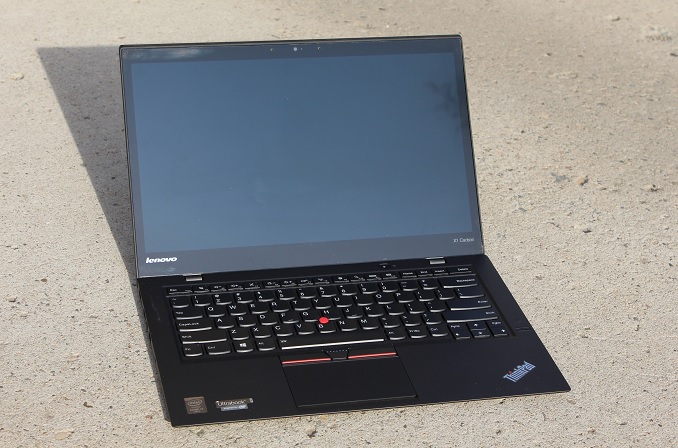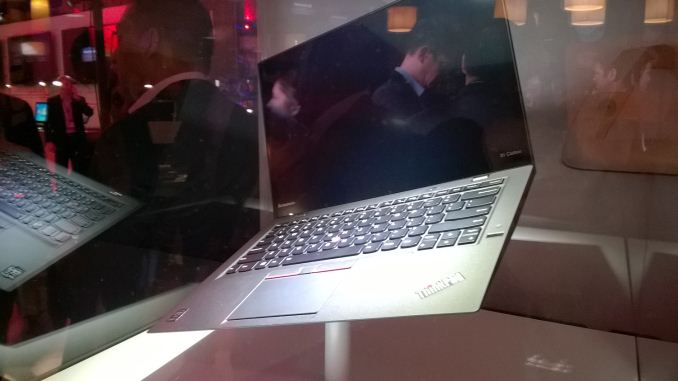The Lenovo ThinkPad X1 Carbon Review (2015)
by Brett Howse on May 21, 2015 8:00 AM EST- Posted in
- Laptops
- Lenovo
- ThinkPad
- Ultrabook
- Broadwell-U

In January of this year, I walked into the Lenovo booth at CES and almost immediately to the right there was a large display case set up, and inside was Eve. Eve looked great in the case all dressed in black, and was well attended to by her hosts. Eve is the one hundred millionth ThinkPad to be created, and I remarked at the time that it was likely not an accident that Eve is a ThinkPad X1 Carbon.
Eve, the 100,000,000th ThinkPad
The X1 Carbon has been Lenovo’s flagship ThinkPad since it was launched, and it brings the world of the ThinkPad business class notebook down into a much thinner and lighter form factor. Today we have the third generation of the X1 Carbon, and although the competition for the best Ultrabook keeps increasing, Lenovo brings a lot to the table with the X1 Carbon.
Lenovo keeps the ThinkPad lineup outfitted with features that the average consumer does not need, and the price is higher accordingly. But if you are someone who travels a lot, and needs a full featured notebook with all of the goodies, you can find it in this X1 Carbon. While the Ultrabook initiative started out with smaller devices, it gradually worked its way up to include larger notebooks as well, and the X1 Carbon certainly fits the bill for an Ultrabook despite the larger than average 14 inch display.
Despite the somewhat larger chassis, the X1 Carbon keeps the weight in check partially through the use of its namesake – carbon fiber. The display cover is created with carbon fiber reinforced plastic, and glass fiber reinforced plastic. This lets the display be lighter, thinner, and stronger than one made of aluminum or plastic alone. And it is strong. You can certainly flex the display, but it never feels like you are going to bend it by accident. The bottom of the X1 Carbon is made of aluminum and magnesium, so it is plenty strong as well. Lenovo even points out that the X1 Carbon has passed eight MilSpecs with fifteen individual tests, including shock, vibration, temperature, humidity, and silica dust exposure.
For many devices, 2015 is the year of the spec bump to Broadwell based processors, and Lenovo is not immune to this. Luckily that is a good thing though, and the new X1 Carbon is now powered by the latest Broadwell-U based processors from Intel. Buyers get a choice of the i5-5200U, i5-5300U, or the i7-5600U processor. None of these are slow, but luckily Lenovo has sent us the i7 model so we can get a feel for how it competes against some of the other Broadwell devices we have seen this year. Let’s take a look at the full specifications below.
| Lenovo ThinkPad X1 Carbon (2015) | |||||
| As Tested, Core i7-5600U, 8 GB RAM, 512 GB SSD, 2560x1440 IPS display with Touch | |||||
| Processor | Intel Core i5-5200U (2C/4T, 2.2-2.7GHz, 3MB L3, 14nm, 15w) Intel Core i5-5300U (2C/4T, 2.3-2.9GHz, 3MB L3, 14nm, 15w) Intel Core i7-5600U (2C/4T, 2.6-3.2GHz, 4MB L3, 14nm, 15w) |
||||
| Memory | 4GB or 8GB DDR3L-1600Mhz | ||||
| Graphics | Intel HD 5500 (24 EU, 300-900 MHz on i5, 300-950 Mhz on i7) | ||||
| Display | 14.0" 1920x1080 TN Optional 2560x1440 IPS Optional Mult-touch |
||||
| Storage | 128GB SATA SSD 180GB or 256GB SATA SSD with Opal 2 Support 512GB PCIe SSD Samsung SM951 |
||||
| Networking | Intel Dual Band Wireless-AC 7265 (802.11ac, 2x2:2, 866Mpbs Max, 2.4 and 5GHz) | ||||
| Audio | HD Audio, Realtek ALC3232 codec Stereo Speakers (downfiring) 1 watt x 2 dual array microphone |
||||
| Battery | 50 Wh Battery 45 Watt charger |
||||
| Right Side | USB 3.0 Ethernet Extender |
||||
| Left Side | USB 3.0 Ports Headset Jack Mini-DisplayPort HDMI Power and OneLink Connector |
||||
| Dimensions | 331 x 227 x 18.5mm (13.03 x 8.94 x 0.73 inches) | ||||
| Weight | 1.27-1.45 kg (2.8-3.2 lbs) | ||||
| Extras | 720p Webcam Backlit Spill-Resistant Keyboard |
||||
| Pricing | $1088-$2300 USD (As Tested: $2100) | ||||
Since this device falls into the ThinkPad line, you get a lot of customization options when purchasing that Lenovo does not do for their consumer models, and that is very welcome because on a lot of devices if you want feature X you have to also buy features Y and Z, which can really bump up the costs. However a few things need to be called out on the X1 Carbon. This is a premium Ultrabook, so it is a bit sad that in 2015 the base model is still offered with just 4 GB of memory, and because this is soldered on (like all of these very thin devices) it would be money well spent to just add the extra $75 Lenovo charges for the 8 GB model. Luckily even though Lenovo calls it 1x8 GB in the guide, it is in fact dual-channel memory. The other big complaint is the 1080p model is offered with a TN panel. That is not really acceptable in a $1000+ device in 2015 any longer. Moving to the QHD version of the panel for $150 would be money well spent since that will bring you an IPS panel.
There are also a lot of options for storage, and the base model comes with just a scant 128 GB of SSD space available, but for not too much more you can bump that up to 180 or 256 GB. For those that need even more storage space and speed, Lenovo offers the SM951 equipped 512 GB PCIe based Samsung SSD. When the X1 first launched, it was a hefty $700 upgrade, but now it is a mere $425 over the base 128 GB offering.
The X1 Carbon is even offered with optional LTE connectivity, via the Sierra EM7345, for those that need mobile data connectivity without tethering.











103 Comments
View All Comments
Brett Howse - Thursday, May 21, 2015 - link
No I don't think so :) But if you do need to be able to run one over, you could get one of these http://www.business.panasonic.com/fully-rugged-lap...fokka - Thursday, May 21, 2015 - link
i agree with most things here. 4gb of RAM isn't acceptable in an ultrabook of the thinkpad brand in 2015 and neither is a TN panel. at least the days of 900p displays are over now and i prefer the 1440p display with rgb stripe to 1800p panels using some kind of pentile matrix.still, for a "professional"-grade ultrabook, which might also be used outside the office, the display is much too dim. under 300nits is a bad showing imho and with ever more efficient displays and LEDs, i would like to see more models approaching the 400nits-mark, instead of struggling to get 300.
i'm also wary of the 128gb starting config, if you ask me there should only be options from 256gb-1tb, but i guess you got to meet the lower price points somehow as well.
i'm glad lenovo came to their minds in regard to the function keys and the track pad buttons, but while they improved battery life, it still is mediocre at best. i think 50wh in a 14-inch form factor that is neither especially thin, nor has remarkably thin bezels is simply too little. 60wh would be much nicer, offering 20% more runtime, and looking how dell stuffs 52wh inside the "miniscule" xps13, 60wh should be manageable on the x1.
regarding I/O the options could be better too. two usb3 ports is the bare minimum i would expect from a thinkpad and opting for a dedicated ethernet extender port doesn't seem like the greatest idea, if you could reach the same goal with another usb port plus ethernet adapter. using usb type-c would be even better for that and you could use it for the docking port as well.
in the end it is a nice and fast machine, that's not cheap when configured properly, that is a big step up from the last iteration (but how could it not be?), but with some mediocre scores when it comes to display and runtime.
for the money one can spend on a higher end x1 i would at least like to see those two main flaws sorted out, otherwise it is a quite nice machine.
meacupla - Thursday, May 21, 2015 - link
Lenovo always lags behind others when it comes to panels offered.It's like they are purposefully obtuse about upgrading product lines to newer hardware, or are trying to make more money by skimping on their top tier products.
I really don't know of any other 'reputable' company that does this with their high end products.
edzieba - Thursday, May 21, 2015 - link
The dock you have pictured is the regular OneLink dock. The OneLink Pro dock has a DVI port in place of the HDMI, adds an extra DisplayPort output, and adds a pair of USB3 ports on the rear.Brett Howse - Thursday, May 21, 2015 - link
Fixed sorry about that!Essence_of_War - Thursday, May 21, 2015 - link
RAM is soldered down, but is the SSD soldered to the logic board also, or is that potentially end-user replaceable?Kristian Vättö - Thursday, May 21, 2015 - link
The SSD is replaceable, that's how I got early access to the Samsung SM951 in the laptop ;-)Essence_of_War - Thursday, May 21, 2015 - link
Good to know that drive failures can be addressed in-the-field!Michael Bay - Thursday, May 21, 2015 - link
I think Lenovo and bad display panels now are more or less synonymous, in notebooks at least.With prices as high as they are, would it kill them to put in something different from usual tn horrorshow for once?
der - Thursday, May 21, 2015 - link
Thank you Brett. Brett is love, Brett is life.